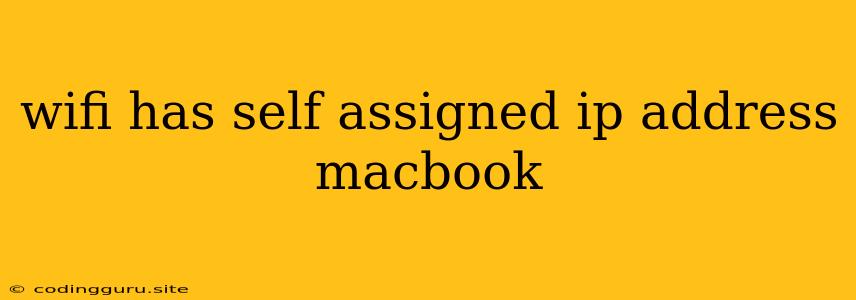Why is My MacBook Getting a Self-Assigned IP Address on Wi-Fi?
It's frustrating when you connect your MacBook to Wi-Fi, but instead of getting a proper IP address, you see a self-assigned IP address like 169.254.x.x. This means your MacBook can't communicate with other devices on your network, making it impossible to browse the web, access shared resources, or even connect to printers.
But don't panic! This isn't a fatal problem, and you can usually fix it with a few troubleshooting steps.
Understanding Self-Assigned IP Addresses
Normally, when you connect to a Wi-Fi network, the router assigns your device a unique IP address. This allows all the devices on the network to communicate with each other. However, if your MacBook is unable to obtain an IP address from the router, it will resort to assigning itself an IP address within the range of 169.254.x.x. This is called Automatic Private IP Addressing (APIPA).
Why Does This Happen?
There are a few reasons why your MacBook might be getting a self-assigned IP address on Wi-Fi:
1. Router Issues:
- DHCP Server Problem: The router's DHCP server might be malfunctioning, unable to hand out IP addresses properly.
- Too Many Devices: If there are too many devices connected to the router, it might run out of available IP addresses.
- Incorrect Router Settings: The router's network settings might be configured incorrectly, preventing your MacBook from obtaining a proper IP address.
2. MacBook Issues:
- Network Adapter Problems: Your MacBook's Wi-Fi network adapter might be experiencing problems.
- Incorrect Network Settings: Your MacBook's network settings could be misconfigured, preventing it from connecting to the router.
- Outdated Drivers: Outdated network drivers might be causing compatibility issues.
Troubleshooting Tips
Here are some steps to troubleshoot the issue and get your MacBook back online:
1. Restart Your Devices:
- Restart Your MacBook: This can resolve temporary glitches and free up network resources.
- Restart Your Router: This will reset the router's DHCP server, allowing it to assign new IP addresses.
2. Check the Network Settings:
- On Your MacBook: Go to System Preferences > Network > Wi-Fi > Advanced. Make sure the Configure IPv4 option is set to Using DHCP.
- On Your Router: Check your router's DHCP settings. Make sure the DHCP server is enabled and that the address range is set correctly.
3. Reset the Network Settings on Your MacBook:
- Go to System Preferences > Network.
- Select the Wi-Fi connection and click the "Advanced" button.
- In the "TCP/IP" tab, click the "Renew DHCP Lease" button.
- Close all windows and try connecting to the Wi-Fi network again.
4. Update Your Network Drivers:
- Go to the Apple Menu > About This Mac > System Report > Network.
- Check the version of your Wi-Fi network adapter drivers.
- If they are outdated, visit the Apple website or your MacBook manufacturer's website to download and install the latest drivers.
5. Change the Wi-Fi Channel on Your Router:
- Log in to your router's web interface.
- Find the Wi-Fi settings.
- **Choose a different Wi-Fi channel. **
- Save the changes and reboot your router.
6. Contact Your ISP:
- If you've tried all the above steps and you're still getting a self-assigned IP address, it might be a problem with your internet service provider (ISP).
- Contact your ISP for support and troubleshooting.
Example Scenario
Let's say you're trying to connect your MacBook to your home Wi-Fi network. Instead of getting an IP address from your router, you see 169.254.129.170.
You can follow the troubleshooting steps above, starting with restarting your MacBook and your router. If that doesn't work, check your MacBook's network settings to ensure DHCP is enabled. You can also try updating your network drivers.
Important Note: If you're still having trouble, it's a good idea to consult a tech expert for more in-depth troubleshooting.
Conclusion
A self-assigned IP address on your MacBook is often a temporary issue that can be resolved with a little troubleshooting. By following the steps outlined above, you can usually get your MacBook back online and connected to your Wi-Fi network.
